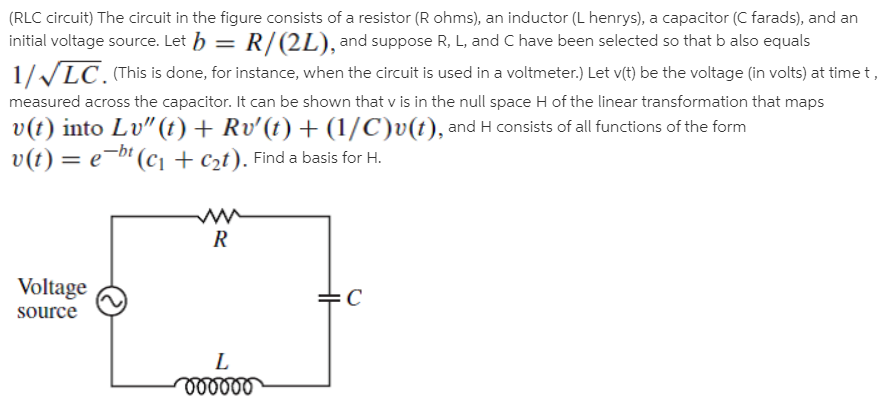(RLC circuit) The circuit in the figure consists of a resistor (R ohms), an inductor (L henrys), a capacitor (C farads), and an initial voltage source. Let h = R/(2L), and suppose R, L, and C have been selected so that b also equals 1//LC. (This is done, for instance, when the circuit is used in a voltmeter.) Let v(t) be the voltage (in volts) at time t, measured across the capacitor. It can be shown that v is in the null space H of the linear transformation that maps v(t) into Lv"(t) + Rv'(t) + (1/C)v(t), and H consists of all functions of the form v(t) = e¬b' (c1 + c2t). Find a basis for H. Voltage source
(RLC circuit) The circuit in the figure consists of a resistor (R ohms), an inductor (L henrys), a capacitor (C farads), and an initial voltage source. Let h = R/(2L), and suppose R, L, and C have been selected so that b also equals 1//LC. (This is done, for instance, when the circuit is used in a voltmeter.) Let v(t) be the voltage (in volts) at time t, measured across the capacitor. It can be shown that v is in the null space H of the linear transformation that maps v(t) into Lv"(t) + Rv'(t) + (1/C)v(t), and H consists of all functions of the form v(t) = e¬b' (c1 + c2t). Find a basis for H. Voltage source
Algebra & Trigonometry with Analytic Geometry
13th Edition
ISBN:9781133382119
Author:Swokowski
Publisher:Swokowski
Chapter4: Polynomial And Rational Functions
Section4.3: Zeros Of Polynomials
Problem 67E
Related questions
Question

Transcribed Image Text:(RLC circuit) The circuit in the figure consists of a resistor (R ohms), an inductor (L henrys), a capacitor (C farads), and an
initial voltage source. Let h = R/(2L), and suppose R, L, and C have been selected so that b also equals
1//LC. (This is done, for instance, when the circuit is used in a voltmeter.) Let v(t) be the voltage (in volts) at time t,
measured across the capacitor. It can be shown that v is in the null space H of the linear transformation that maps
v(t) into Lv"(t) + Rv'(t) + (1/C)v(t), and H consists of all functions of the form
v(t) = e¬b' (c1 + c2t). Find a basis for H.
Voltage
source
Expert Solution
This question has been solved!
Explore an expertly crafted, step-by-step solution for a thorough understanding of key concepts.
This is a popular solution!
Trending now
This is a popular solution!
Step by step
Solved in 2 steps with 2 images

Recommended textbooks for you

Algebra & Trigonometry with Analytic Geometry
Algebra
ISBN:
9781133382119
Author:
Swokowski
Publisher:
Cengage

Elementary Geometry for College Students
Geometry
ISBN:
9781285195698
Author:
Daniel C. Alexander, Geralyn M. Koeberlein
Publisher:
Cengage Learning

Linear Algebra: A Modern Introduction
Algebra
ISBN:
9781285463247
Author:
David Poole
Publisher:
Cengage Learning

Algebra & Trigonometry with Analytic Geometry
Algebra
ISBN:
9781133382119
Author:
Swokowski
Publisher:
Cengage

Elementary Geometry for College Students
Geometry
ISBN:
9781285195698
Author:
Daniel C. Alexander, Geralyn M. Koeberlein
Publisher:
Cengage Learning

Linear Algebra: A Modern Introduction
Algebra
ISBN:
9781285463247
Author:
David Poole
Publisher:
Cengage Learning